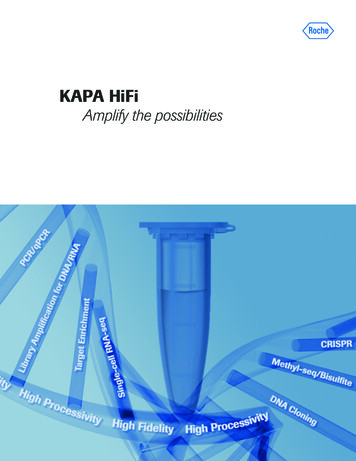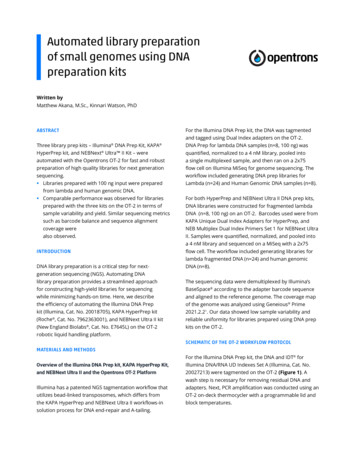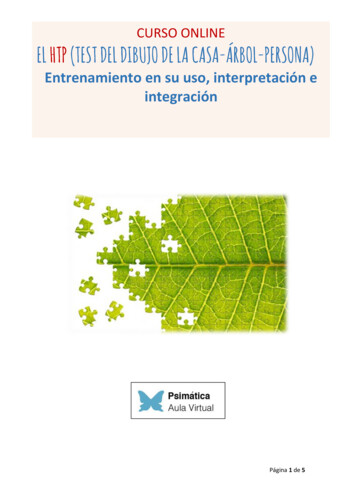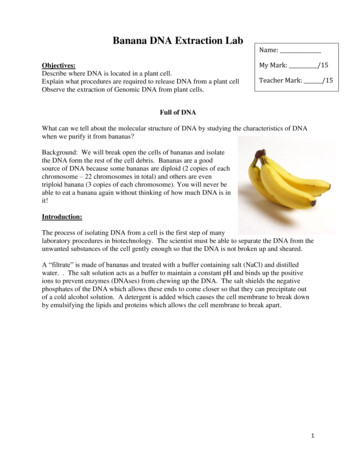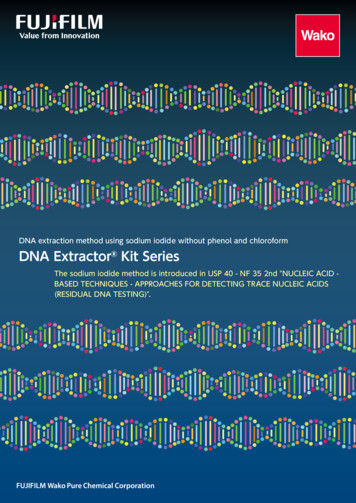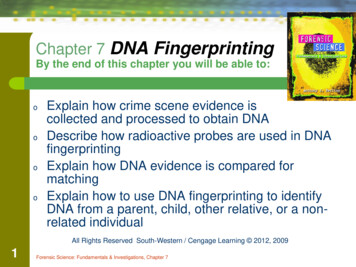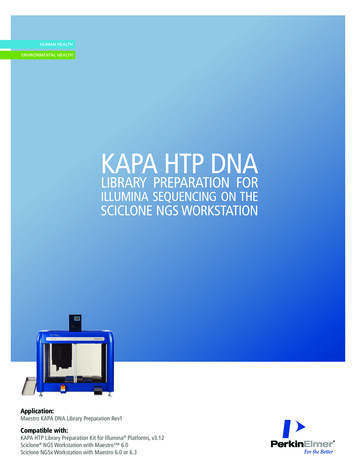
Transcription
KAPA HTP DNALIBRARY PREPARATION FORILLUMINA SEQUENCING ON THESCICLONE NGS WORKSTATIONApplication:Maestro KAPA DNA Library Preparation Rev1Compatible with:KAPA HTP Library Preparation Kit for Illumina Platforms, v3.12Sciclone NGS Workstation with Maestro 6.0Sciclone NGSx Workstation with Maestro 6.0 or 6.3
Maestro KAPA DNA Library Preparation Rev1Table of Contents2Introduction3Maestro KAPA Library Prep Workflow Overview3Required Materials and Reagents5Reagents5General Lab Equipment and Supplies5Sciclone NGS Workstation Accessories5Consumables6Running the Maestro KAPA Library Prep Application6Sample Preparation6KAPA Library Prep Run Preparation Steps6PCR Enrichment8KAPA Post-PCR SPRI Run Preparation Steps9Library QC and storage10Expected Results10Appendix A: Step-by-Step Guide to the KAPA Library Prep Application11Appendix B: Step-by-Step Guide to the KAPA Post-PCR SPRI Application12
Maestro KAPA DNA Library Preparation Rev1IntroductionPreparation of DNA samples for cluster generation andsequencing on the Illumina platform requires a seriesof manipulations to efficiently ligate appropriate indexedadapters onto DNA fragments to produce paired-end libraries.Automating the process has the advantage of avoiding sampletracking errors and reducing sample-to-sample variabilitywhile dramatically increasing throughput. The Maestro-basedKAPA Library Prep Workflow from PerkinElmer provides a preprogrammed solution for sample preparation on the ScicloneNGS workstation for KAPA Biosystems’ KAPA HTP LibraryPreparation Kit v3.12.Figure 1. Overview of the steps for KAPA library preparation on theSciclone NGS WorkstationMaestro KAPA Library Prep Workflow OverviewThe Maestro Application for KAPA library preparation is avalidated process for library preparation from fragmented DNAsamples that follows the steps outlined in Figure 1. Samplesare processed in 96-well PCR plates. The number of samplesto process (1 to 12 columns of 8 samples each) is selected atthe start of each run. Tip-tracking utilities guide partial tip boxloading and ensure that each tip box is used to completion priorto starting the next box. Inheco temperature blocks installedon the Sciclone NGS Workstation deck allow for appropriate4 C storage of reagents and heated incubations of reactions.Reaction mixes are pre-arrayed prior to addition to sample toensure equal incubation times across the sample plate. Adapterindexing patterns may be executed during the run by arraying 1- 24 different adapters to appropriate well locations as specifiedby the user in an Excel workbook. Easy-to-follow user interfacesguide the reagent and deck setup process and prompt the userfor any necessary interventions.Maestro ApplicationSet-upTimeRun Time (includingthermocycler steps)KAPA Library Prep1 hour5-6 hoursKAPA Post-PCR SPRI10 min45 minTwo independent Maestro Applications are used in the 1-dayKAPA Library Prep Workflow.The Maestro KAPA sample preparation closely follows theprotocol recommended by KAPA Biosystems. A single aliquotof AMPure XP beads is used per sample for the post-EndRepair, post-A-tailing and post-Ligation SPRI steps. This strategyincreases yield by limiting the number of times samples aretransferred to new wells/plates and decreases the cost of theassay by reducing AMPure XP bead consumption. For SPRIcleanup steps, the DNA in the sample is driven onto the beadsvia addition of PEG/NaCl SPRI solution. For the A-tailing andLigation steps, DNA is eluted from the beads directly into thereaction mixture. In the Maestro KAPA Library Prep application,the amount of water in the A-tailing and Ligation master mixesis reduced, and the reaction is assembled in two steps. First, 30µL water is dispensed into the wells with DNA/beads. Second,20 µL of master mix is dispensed into the wells and the DNA/beads are resuspended in 50 µL total reaction volume. Addingwater to the beads separately allows the reaction master mixesto be pre-arrayed by the Sciclone NGS workstation into a 384well staging plate. Use of the 384-well staging plate reducesthe consumables needed in the workflow, while ensuring thatreaction mixes are added simultaneously to all wells of thesample plate.Three different workflow options are available for post-ligationcleanup of samples prior to setup for PCR enrichment of thelibraries. The “Single SPRI” option performs a single “0.5X”cleanup step before PCR setup. After the ligation reactionincubation, 25 µL of PEG/NaCl SPRI solution are added to each50 µL ligation reaction. After the SPRI cleanup, DNA is eluted in22 µL 10 mM Tris pH 8.0 and 20 µL is transferred into the PCRreaction. The “Double SPRI” option performs two consecutive,“1X” post-ligation SPRI cleanups. After the ligation reactionincubation, the first post-ligation SPRI cleanup as describedabove, except that 50 µL of PEG/NaCl SPRI solution is addedto each 50 µL ligation reaction, and elution is in 50 µL 10 mMTris pH 8.0. To the 50 µL eluted sample, 50 µL PEG/NaCl SPRIsolution is added for a second SPRI cleanup and elution is done in22 µL 10 mM Tris pH 8.0. The “Size Selection” option performsa dual “0.55X – 0.75X” SPRI size selection. The initial “1X”post-ligation SPRI cleanup is performed, with elution in 100 µL10 mM Tris pH 8.0. To the 100 µL sample, 55 µL PEG/NaCl SPRIsolution is added to bind fragments larger than 450 bp. Afterwww.perkinelmer.com/ScicloneNGS3
Maestro KAPA DNA Library Preparation Rev1Incubate 30 min at 37C;Broadcast Adapters to384-well plateSPRI cleanup, 90 µLPEG/NaCl, elute in 25 µLwater, leave on beadsbinding, the supernatant is transferred from the beads to a platecontaining 20 µL fresh.AMPure XP reagent. The concentrationof PEG/NaCl in this second plate favors binding of fragments 200 bp in size. After washing the beads with ethanol anddrying, the 250 - 450 bp fragments are eluted into 22 µL 10 mMTris pH 8.0 and 20 µL is transferred to the PCR reaction.During startup of the KAPA Library Prep application, the user willbe prompted to select the desired workflow in the window shownin Figure 2. The appropriate choice for post-ligation cleanupdepends on the user’s workflow and the intended downstreamprocessing of amplified library samples. Please consult the KAPABiosystems Technical Data Sheet for the KAPA HTP LibraryPreparation Kit for guidance on adapter concentrations, PCRcycling parameters and post-ligation cleanup options.Figure 2. Selection of Post-ligation SPRI cleanup option.Broadcast 22 µL EndRepairMix to 96-well plateTransfer 20 µL Ligase Mixand 5 µL adapter to sampleTransfer 20 µL EndRepairMix to 50 µL sampleIncubate 15 min at 20CIncubate 30 min at 20C;Broadcast A-Tail mix andLigase mix to 384-plateSPRI cleanup, 50 µLPEG/NaCl, elute in 22 µLSPRI cleanup; 120 µLbeads, elute in 30 µL water,leave on beads(Optional: repeat SPRIcleanup or Dual SPRI sizeselection. Elute in 22 µL EB)Transfer 20 µL A-Tail Mix tosample and mixBroadcast 30 µL; PCR MMto PCR plateIncubate 30 min at 37C;Broadcast Adapters to384-well plateTransfer 20 µL sampleto PCR plateSPRI cleanup, 90 µLPEG/NaCl, elute in 25 µLwater, leave on beadsAmplify on ThermocyclerFigure 3. KAPA Library Prep application stepsTransfer 20 µL Ligase Mixand 5 µL adapter to sampleTransfer 50 µL PCR reactionto clean plateIncubate 15 min at 20CAdd 50 µL AMPure beads;SPRI cleanup, elute in 32 µLSPRI cleanup, 50 µLPEG/NaCl, elute in 22 µLTransfer 30 µL libraryto clean plate(Optional: repeat SPRIcleanup or Dual SPRI sizeselection. Elute in 22 µL EB)QC and store at -20CBroadcast 30 µL; PCR MMPCR plateFigure 4. toKAPAPost-PCRSPRI application stepsTransfer 20 µL sampleto PCR plateAmplify on Thermocycler4
Maestro KAPA DNA Library Preparation Rev1Required Materials and ReagentsReagentsReagentVendor and Part No.KAPA HTP Library Preparation Kit v3.12 for Illumina Platforms (96 samples)KAPA Biosystems KK8234Indexed Y-adapters of the Illumina TruSeq designVariousPCR primers of the Illumina TruSeq designVariousNuclease-Free WaterVariousAmpure XP reagentBeckman Coulter-- A63881 (60 mL) 100% EtOHSigma E702310 mM Tris pH 8.0VariousNote: KAPA HTP kits supply enough reagents to process 96 samples. While overage volumes are generous, if kits are used in numerous runs with 96 samples per runvolumes of specific reagents may become limiting. Take care to store and handle KAPA reagents as specified and avoid multiple freeze-thaw cycles.Note: Adapters and PCR primers are not supplied with the KAPA HTP Library Preparation Kit, and must be obtained separately.General Laboratory Equipment and arious200 µL Multichannel pipettor and appropriate barrier tipsVarious1000 µL Multichannel pipettor and appropriate barrier tipsVariousCovaris S2 or E210 System and appropriate tubesCovaris Microplate centrifugeVariousThermocycler**BioRad (MJ Research) DNA Engine PTC-200, or equivalentPlate SealsVarious- compatible with Thermocycler and freezer storageLabChip GX or Agilent Bioanalyzer 2100 with appropriate chips and reagentsVarious **The standard sample plates used in this application are fully skirted Bio-Rad Hard-Shell 96-PCR plates. Please check if your thermocycler is compatible with this platetype. If it is not, please contact your PerkinElmer Field Application Scientist to discuss modifications to the application to support semi-skirted PCR plates. Sciclone NGS Workstation AccessoriesAccessoryPart No.Agencourt 96-ring magnetCLS 128316Inheco 384-well plate adapterCLS 100853Inheco 96-well adapters (2)CLS 128372Inheco 96-well adapter/shakerCLS 100852www.perkinelmer.com/ScicloneNGS5
Maestro KAPA DNA Library Preparation Rev1ConsumablesConsumableDescriptionPCR Plates*96-well PCR Plate, Bio-Rad Hard-Shell , Full SkirtPerkinElmerPart No.Vendor andPart No.6008870Bio-Rad HSP-9631Boxed Tips*Pipette Tip-150 µL, Art, Box, 10-96 Sterile Racks111426No. Usedper Run10-1220-26(96 samples)Deepwell PlatesDeepwell-96 POS, Square 2.0 mL well, Polypro, Seahorse6008880Seahorse Bioscience201379-1002Deepwell Reservoirs Reservoir-Deepwell, 12-col Pyramid Bottom, 290 mL, Seahorse6008730Seahorse Bioscience201250-1002Lids946 Lid-Universal, Robotic Friendly, Polystyrene6000030Seahorse Bioscience200856-1006384-well Plate1Microplate-384-well, Round Bottom, Polypropylene, Pkg of 106008890Corning, Inc. 3672*Plate and tip usage will depend on selected post-ligation cleanup option.Running the Maestro KAPA Library Prep WorkflowPlease read and familiarize yourself with all steps described inthis section prior to beginning the run. For best results, theentire process should be completed in one day. Allow 6 - 7hours to complete all steps, including reagent distribution, decksetup, end-repair, A-tailing, ligation, PCR enrichment, and postPCR cleanup of samples.The sample number must be set by indicating the number ofcolumns to run in the worksheet titled “KAPA Library Prep”. TheMaestro application only processes full columns of 8 samples each.Sample preparationGenomic DNA should be fragmented to an average size of 300 400 bp on a Covaris S2 or E210 instrument. Samples should bepresented for the Maestro KAPA Library Prep run as 100 ng to 5µg sheared DNA in 50 µL 10 mM Tris pH 8.0, low TE, or waterin a BioRad Hardshell 96-well PCR plate.KAPA Library Prep Run Preparation StepsNote: AMPureXP beads and PEG/NaCl SPRI solution beequilibrated to room temperature for about 30 minutes beforeuse. They may be taken out of 4 C storage before beginning. Donot thaw KAPA reagents until steps 1 and 2 have been completed.If necessary, boot up the system by first starting the Sciclone andthe Inheco units, then starting the PC controller.1. Modify the Maestro KAPA Library Prep Workbook tospecify the number of samples to run and the adapterindex pattern.The workbook must be located in the filepath: C:\ProgramData\Caliperls\Maestro\Workbooks\ and must have the name “KAPALibrary Prep Workbook.xls”. If the file is moved or the nameis changed, Maestro will not be able to find the informationnecessary to begin the run.6Figure 5. “KAPA Library Prep” worksheet.The adapter index pattern is set by designating the appropriateadapter numbers to each well ID in spreadsheet titled “AdapterIndexing”. Up to 32 different adapters may be used, but thedefault setting for the spreadsheet will show the 24 indexnumbers used in the Illumina TruSeq design. TruSeq adapters are numbered from ID001 to ID027, with adaptersID017, ID024 and ID026 omitted. If desired, alternative namesmay be entered in column I.Enter a number in column B indicating which of the indexes isto be used for each of the samples to be run. The chart on theright will automatically update the number of samples using eachadapter index. This information will be passed into the KAPALibrary Prep worksheet to indicate the appropriate well and thevolume necessary for each adapter index mix.Save the modified spreadsheet with its original name in itsoriginal file path. Print the “KAPA Library Prep” spreadsheetto use as a guide while setting up reagents.
Maestro KAPA DNA Library Preparation Rev1Figure 6. “Adapter Indexing” spreadsheet in the “KAPA Library Prep” Workbook.2. Start the Maestro KAPA Library Prep ApplicationLaunch he Maestro software and open the KAPA Library PrepApplication. Start the run by selecting the play button. Ifrunning in Editor Mode, be sure to start the Main Method.Note: When the run is started, the instrument will complete allinitialization steps for the hardware and the specific application.The run will automatically pause and prompt the user to set upthe deck and confirm proper setup prior to beginning the librarypreparation steps. Starting the application prior to thawing anddiluting reagents ensures that the cold blocks are pre-chilled andready for on-deck reagent storage.Ensure that the Inheco units have the correct adaptersfor the run:Position A3Position A4Position D2Position D496-well PCR Plate Adapter384-well Plate Adapter96-well PCR Plate Adapter96-well PCR Plate Shaker AdapterVerify that the Inheco units for positions A3, A4 are set to4 C and are cooling.3. Prepare the 80% EtOH and Water ReservoirsMake 100 mL fresh 80% EtOH solution by diluting 80 mL 100%Ethanol with 20 mL nuclease-free molecular biology gradewater. Pour 100 mL fresh 80% EtOH into a Seahorse deepwellreservoir, cover with a lid and store at room temperature.Prepare a second Seahorse deepwell reservoir with 50 mLNuclease-free water.4. Prepare PEG/NaCl, 10 mM Tris pH 8.0, andAMPure XP bead platesUse the KAPA Library Prep spreadsheet as a guide for setting upthe plates.Using a multichannel pipettor, aliquot the appropriate volume ofPEG/NaCl solution per well into a BioRad Hardshell PCR platefor each column of samples to be run. The volume of PEG/NaClsolution will differ depending on which post-ligation SPRI optionhas been chosen for the workflow. Label the plate, cover with alid, and store at room temperature.Using a multichannel pipettor, aliquot 162 µL 10 mM Tris pH8.0 per well into a BioRad Hardshell PCR plate for each columnof samples to be run. Label the plate, cover with a lid, and storeat room temperature.Thoroughly resuspend AMPureXP beads by inverting or rotatingthe AMPure XP reagent container. Using a multichannelpipettor, aliquot 125 µL AMPureXP beads per well into aBioRad Hardshell PCR plate for each column of samples to berun. Cover the plate with a lid and store at room temperature.If the “Size Selection” workflow is to be run, additional platescontaining 20 µL AMPure XP reagent (resuspended beads) and70 µL PEG/NaCl solution will be needed at the start of Step 5.These plates may be prepared at this time or after the ScicloneNGS Workstation run has been started.Inspect all plates to ensure that air has not been trapped in thewells. If necessary, spin the plates briefly to bring reagents tothe bottom of the wells.7
Maestro KAPA DNA Library Preparation Rev15. Make the reaction master mixes and adapter mixes8. Run the KAPA Library Prep StepsThe following mixes should be prepared according to the recipesin the KAPA Library Prep spreadsheet: End-Repair Mix, A-TailingMix, Ligation Mix, and PCR Mix.Confirm that the deck setup matches the final picture in thesetup window. Selecting “Finished” will prompt the applicationto begin the library prep protocol.Thaw the KAPA reagents stored at -20 C on ice. Ensure thateach KAPA supplied component has been fully thawed, gentlymixed, and spun down before use. After adding the appropriatevolumes of reagents in nuclease-free tubes, gently mix and spinagain to collect all liquid at the bottoms of the tubes.The Maestro KAPA Library Prep Application will automaticallyproceed through End Repair, A-tailing, Ligation, and PCRsetup steps as indicated in the flowchart on page 4. Whilethe application is running, the green light at the top of theinstrument will blink. If there is a problem with the run, the lightwill change to yellow and an alarm will sound to indicate thatuser intervention is necessary. See Appendix A for a Step-by-Stepguide to the Sciclone NGS Workstation steps of the KAPA LibraryPrep Application.Care should be taken to pipet accurately as minimal overagevolumes are used. Keep the reaction mixes on ice. Promptlyreturn unused portions of reagents to -20 C storage.6. Aliquot the reaction mixes and adapters into platesUse the KAPA Library Prep spreadsheet as a guide for setting upthe Master Mix plate.Aliquot the appropriate volume of each indexed adapter in theindicated well in column 9 - 12.Aliquot the specified volumes of End Repair Mix, A-tailing Mix,Ligase Mix, and PCR Mix to columns 1 through 8. Keep theplate on ice while pipetting to keep the reagents cold. Pipetcarefully into the bottom of the wells and avoid trapping air orcreating bubbles. If necessary, spin the plate briefly in a platecentrifuge to ensure all reagents are at the bottom of the wells.Label the plate, cover with a lid and store on ice or at 4 C.7. Set up the Sciclone deckConfirm that the software has correctly read the workbook andis set to run the correct number of columns. If the incorrectnumber of columns is indicated, modify and save the KAPALibrary Prep workbook as described in Step 1, then start theapplication again from the Main method.Step through the pictures, placing the appropriate consumables/prepared plates in the indicated locations. Be sure to checkwhether a lid is needed for each plate or reservoir. Place new tipboxes in the indicated locations.If the “Size Selection” option has been set for the library prepworkflow, the application will pause at the completion of thepost-ligation SPRI cleanup. A message will prompt the userto replace the plate at C2 with a plate containing 20 µL freshAMPureXP beads and to replace the plate at B2 with fresh PEG/NaCl SPRI solution.When the PCR setup is complete, the application will pause andshow a message indicating that the PCR plate should be sealedand placed on a thermocycler for the amplification step. Closethe dialog box to complete the run and shut down the leg lightsand Inheco temperature controls.Note: The 10 mM Tris pH 8.0 and 80% EtOH plates may beretained for use in the Post-PCR SPRI cleanup.PCR AmplificationKAPA recommends the following program for amplification oflibraries. The number of cycles should be optimized accordingto the amount of input DNA in the sample. Use a heated lid toprevent condensation.PCR:98 C for 45 seconds5-10* cycles of:98 C for 15 seconds60 C for 30 seconds72 C for 30 seconds72 C for 60 secondsHold at 4 C*Please consult the KAPA HTP NGS Library Preparation Technical Guide forinformation regarding optimization of library amplification.8
Maestro KAPA DNA Library Preparation Rev1KAPA Post-PCR SPRI Run Preparation StepsThe KAPA Post-PCR SPRI cleanup step is provided as a separateMaestro application. If desired, the user may designate adifferent liquid handler for post-PCR sample processing toavoid any possible cross-contamination of pre-amplificationsamples. Post-PCR SPRI cleanup applications are available forboth the Sciclone NGS and the Zephyr NGS Workstations.The instructions here are for running the KAPA Post-PCR SPRIapplication on the Sciclone NGS Workstation.Note: AMPureXP beads should be equilibrated to roomtemperature for about 30 minutes before use. They should betaken out of 4 C storage when the PCR Amplification step isstarted.1. Open the KAPA Library Prep WorkbookIn the KAPA Post-PCR SPRI worksheet, enter the number ofcolumns to be processed and save the workbook. The workbookmust be located in the filepath: C:\ProgramData\Caliperls\Maestro\Workbooks\ and must have the name “KAPA LibraryPrep Workbook.xls.” If the file is moved or the name is changed,Maestro will not be able to find the information necessary tobegin the run.Figure 7. KAPA Post-PCR SPRI worksheet.2. Start the KAPA Post-PCR SPRI ApplicationLaunch the Maestro software and open the “KAPA Post-PCRSPRI” application. Start the run by selecting the play button. Ifrunning in Edit mode, be sure to start the Main Method.Note: When the run is started, the instrument will complete allinitialization steps for the hardware and the specific application.The run will automatically pause and prompt the user to set upthe deck and confirm proper setup prior to beginning the librarypreparation steps.3. Prepare the AMPure XP Beads Plate and 10 mMTris pH 8.0 PlateAliquot 55 µL of AMPure XP reagent (resuspended beads) perwell in a BioRad Hardshell PCR plate. Ensure that the beads areat room temperature and well mixed prior to pipetting.If the 96-well BioRad Hardshell PCR plate containing 10 mMTris pH 8.0 used in the KAPA Library Prep application is saved atthe completion of the library prep steps, the same plate may beused during the post-PCR cleanup. Confirm that enough volumeremains in the wells (30 µL plus 5 µL overage volume in eachwell), or set up a new plate as indicated in the workbook.4. Prepare 80% Ethanol ReservoirIf the 80% EtOH reservoir used in the KAPA Library Prep run hasbeen retained, it can be used for this run. Otherwise, make 50mL fresh 80% EtOH solution by diluting 40 mL 100% Ethanolwith 10 mL nuclease-free molecular biology grade water. Pour50 mL fresh 80% EtOH into a Seahorse deepwell reservoir andcover with a lid.5. Setup the Sciclone DeckConfirm that the software has correctly read the workbook andis set to run the correct number of columns. Step through thepictures, placing the indicated consumables/prepared platesin the indicated locations. Be sure to check whether a lid isneeded for each plate or reservoir. Place new tip boxes in theindicated locations.Note: When the KAPA Post-PCR SPRI application is started, thevariables used for tip tracking are reset. The run must be startedwith new, full tip boxes in the indicated positions, as Maestrowill not retain tip tracking information from the library prep run.6. Run the “KAPA Post-PCR SPRI” stepsConfirm that the deck setup matches the final picture in thesetup window. Selecting “Finished” will prompt the applicationto begin the library prep steps. See Appendix B for a Step-byStep guide to the Sciclone steps of the KAPA Post-PCRSPRI application.When the run is complete, the application will pause and showa message indicating that the sample plate should be sealed andstored appropriately. Close the dialog box to complete the runand shut down the leg lights and Inheco temperature controls.9
Maestro KAPA DNA Library Preparation Rev1Library QC and storageExpected ResultsSeal the library plate and store at -20 C for up to 7 days,or proceed directly into library validation prior to storing.The LabChip GX may be used to check the size distributionof fragments in the amplified library and estimate theconcentration of fragments in the appropriate size range. Makea 1/25 dilution of library into molecular biology grade water ina BioRad Hardshell skirted 96-PCR plate. Mix well by pipettingup and down, and spin the plate to remove any bubbles. Runthe samples on the GX using a High Sensitivity DNA chip and kitaccording to the standard LabChip protocol.Additional/alternative validation and quantification, includingqPCR quantification, should be done according to the user’sstandard practices.Figure 8: Data tracing from LabChipGX analysis of 1:25 dilutions of inputDNA (red) and final library amplified with 6 PCR cycles (blue).Figure 9: Gel image from LabChipGX analysis of 1:25 dilutions of KAPA librarypreps from 24 replicate samples of 500 ng total Human DNA (Promega G1471).Figure 10: Yield data from LabChipGX analysis of 24 replicate library prepsshown in figure 9.10
PerkinElmer, Inc.940 Winter StreetWaltham, MA 02451 USAP: (800) 762-4000 or( 1) 203-925-4602www.perkinelmer.comFor a complete listing of our global offices, visit www.perkinelmer.com/ContactUsCopyright 2013, PerkinElmer, Inc. All rights reserved. PerkinElmer is a registered trademark of PerkinElmer, Inc. All other trademarks are the property of their respective owners.010854 0112Feb 2013
During startup of the KAPA Library Prep application, the user will be prompted to select the desired workflow in the window shown in Figure 2. The appropriate choice for post-ligation cleanup depends on the user's workflow and the intended downstream processing of amplified library samples. Please consult the KAPA
